Innovation Methods: the What, Why and How
What’s the best way to approach innovation? Should you have a hackathon, a design sprint, or maybe a brainstorming session? Should you start an ideation process to find the next best thing, or should you gather ideas to improve your products? These are just some of the most common questions we hear from innovators.
It seems like we are wired to always look for the perfect method to fix problems. So, understandably, when it comes to innovation everyone wants to find the perfect method, the silver bullet. However, obsessing over a single best innovation recipe comes with the risk of getting stuck in the old ways of doing things.
Every type of innovation has a complex setting, with many variables, so copying the exact same model of doing innovation is not feasible or at least it won’t reap the desired results. What can and should be replicated, is the disciplined way of achieving innovation. And this is where innovation methods come into play.
Since the right mix of methods isn’t the same for everyone, we wrote this guide to help you choose the right methods for your case. In this article we'll take you through the most common innovation methods, how to choose them as well as when to use them.
Table of contents
What is an innovation method?
There isn’t a real consensus on what an innovation method actually is, but we will briefly explain our approach so it’s easier to understand the context. Some people might talk about methods, tools or processes when referring to the same thing, but there are clear differences that we’ll explain below.
A process is a series of events or a path of successions that help produce a result. A tool is any instrument that helps you put a method into practice. So, we talk about tools as anything that helps us perform a specific job.
A method is generally defined as a procedure through which something is approached or accomplished systematically. Basically, it’s the way we do something according to a plan, in order to achieve a desired result. So, the innovation methods we will discuss are simply that: the practical ways in which we can achieve innovation.
Understanding the existing innovation methods can help you approach different issues from different angles and ensure that questions are addressed in the right way. Our goal is to help you navigate these methods so you can build a toolbox to scale and systematize innovation.
Why it’s important to choose the right innovation methods
Innovation as a sporadic initiative is rarely a long-term success. A systematic approach increases the chances of valuable innovation. We believe a structured way of doing innovation is imperative. However, sticking to a single method is not ideal, especially for large organizations.
Thus, the best way to go about this is to create your own toolbox and include various methods for different purposes and kinds of innovations. It might be a little more work initially than simply choosing one and reusing that over and over again, but in the long term, it pays off. How exactly?
The best way to go about this is to create your own toolbox and include various methods for different purposes and kinds of innovations.
-
Bring the best ideas to life
Having a mix and match approach for innovation methods will help you bring more, and more diverse ideas to life. Unconventional ideas can lead to breakthrough innovations, but they’re probably the hardest to bring about. In order to have these unconventional ideas, you need to create the space and time for them.
Choosing the right innovation methods also means that you allow time for reflection, ideation, evaluation and prioritization of the best ideas. All these steps put together contribute to bringing the best ideas to life.
-
Test assumptions and reveal new business opportunities
Some of the innovation methods we’ll go through emphasize experimentation as an important step to turn ideas into workable solutions. The lean startup method, for example, uses experiments to test assumptions, learn fast and iterate. As it’s wisely said, you should test to improve, not to prove.
Design thinking enables you to identify new opportunities by deeply understanding your customers and generating new ideas with help from employees. Companies like Apple, GE or IBM are actively using design thinking to solve problems. They also used other innovation methods to empower employees to better understand opportunities.
-
Help scale innovation within the organization
In this day and age, you can’t rely on just a few people in the organization to be in charge of innovation. To scale innovation within the entire organization you have to enable anyone to become an innovator. Having the right tools and methods can help you harness the creativity and knowledge of the entire workforce.
Seven common innovation methods
In the plethora of innovation methods, it’s hard to pick just a few. As mentioned earlier, ideally you create your own toolbox of methods, processes and tools that suit your needs and the stage of innovation. To help you with that, we picked some of the most used innovation methods that can be applied throughout a variety of industries and companies.

It’s good to keep in mind that regardless of the methods you choose, you first need to design an innovation pipeline process from start to deployment. To make things easier, we’ll first explain the core principles of each method and we’ll continue with the stages of an innovation process and where these methods fit in.
1. Innovation mapping
What is about: Innovation mapping is a method that paints a general picture of the innovation landscape. Through this method we look at the sources of previous innovations and we map the origin of those ideas, whether they were successful or not.
How it’s done: Innovation mapping can be seen as a pipeline that includes four steps: questions, sources, methods and outcomes.
You first establish the questions you need answers to, like when or where innovation happened in your specific ecosystem, what are the existing gaps, who are the other actors involved and how they are connected. Next, you start gathering data form different sources: online, open data, services etc. Once you have everything together you analyze and make the information available to those concerned. 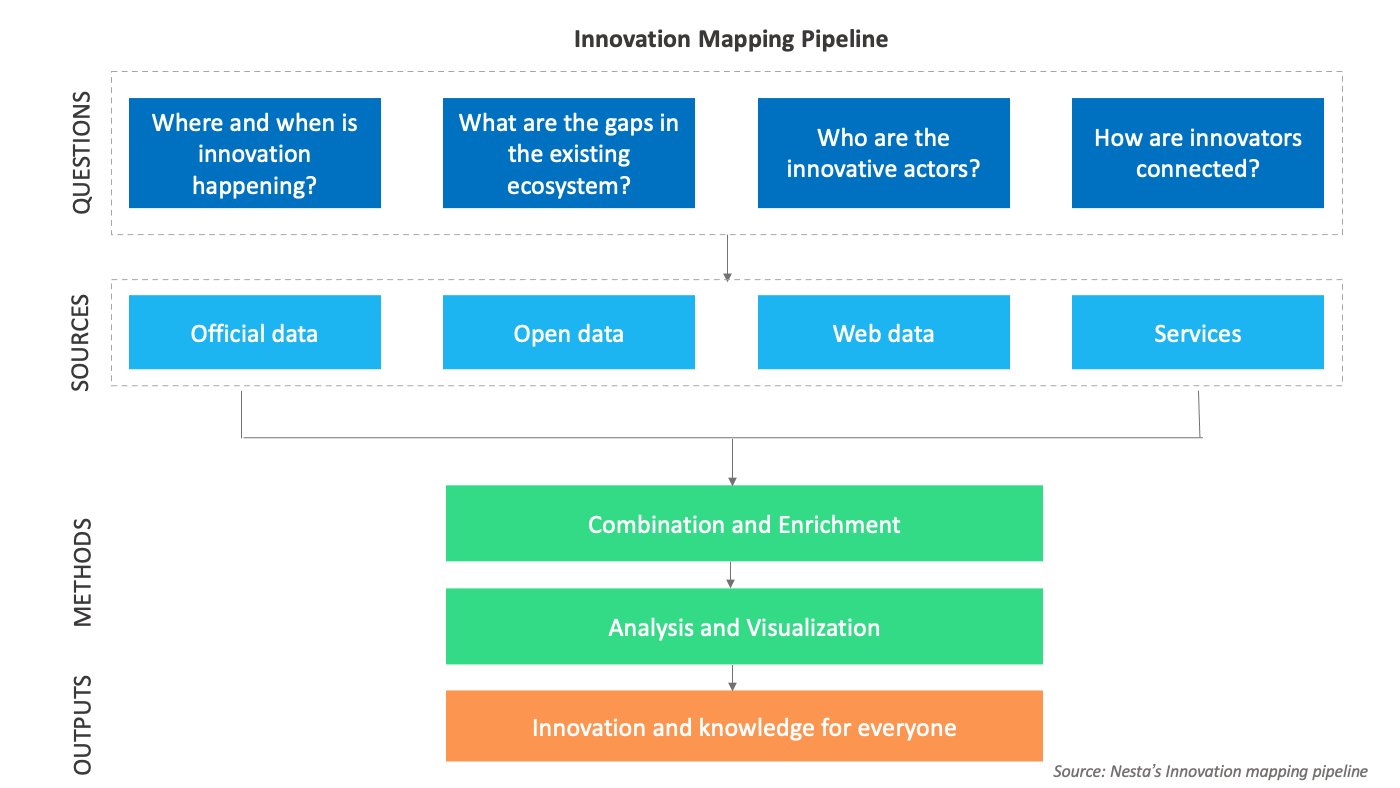
Why choose it:
This method is useful in the decision-making process and can help you:
- Understand how innovation happens in your specific industry
- Analyze the outcome of other innovations in areas relevant for you and identify the factors that lead to their success or failure.
- Make better, and more strategic decisions for your future innovation
- Identify gaps and opportunities for innovation and turn them into actionable strategies
For example, Nesta has used this method to map the UK gaming industry over time. With big data they tracked the evolution of the industry and used the information together with other stakeholders to help them develop smarter strategies that support future innovation and growth in the industry.
Innovation maps can also be used internally, to assess your existing products and services and see which ones need improvements. You can download our guide to Types of Innovation that comes with an Innovation Map template to use when approaching innovation.
2. Hackathons
What is about: Hackathons are time-bound events that bring together a large number of people to develop a solution to a main challenge. Standard hackathons run for a short period of time and their final goal can be to solve a problem, build a prototype or research a new service.
Companies also use hackathons as innovation methods to get new ideas and break away from old habits. A hackathon is in essence a collaborative exercise that traditionally involves competing teams, but in the corporate environment it also became a team building exercise that supports the company’s innovation goals.
How it’s done: For hackathons to work in the corporate setting you have to make sure that those involved can invest 2-3 days away from their everyday work, that you can move quickly, and you have the resources to further explore and develop the results after the program.
If you want to reap the benefits of a hackathon you should focus on market validation and on understanding the customer jobs to be done, the value proposition and on testing your assumptions.

For example, Facebook is organizing hackathons where employees generate new ideas and work on making initial versions of them. There’s a common misconception that hackathons are for developers or designer, but as Facebook also proved, bringing together employees from various fields helps team become more cohesive. Collaborating with someone you usually don’t work with, even for a short time, can support outside-the-box creative thinking and lead to new, innovative ideas.
Why choose this: Hackathons can be set in different environments to serve various goals. This makes them versatile in scope and in benefits too:
- A fast way to come up with fresh, new ideas that can lead to valuable innovations
- For companies that are not used to taking risks, this is their chance to take a leap of faith and see what happens when they break free from the norms. Because it takes place over a short period of time the risks are lower, and the investments are not high
- As you bring together people that normally wouldn’t work together, hackathons can help employees uncover other opportunities, projects they weren’t aware of and unlock their creativity and enable a new way of thinking
However, hackathons should also be taken with a grain of salt. While there have been countless examples of companies getting value from hackathons, there are also risks associated with it like innovation theater. If you are not sure about investing a full-on weekend long hackathon, you can first try out shorter practices like idea challenges.
If you are not sure about investing a full-on weekend long hackathon, you can first try out shorter practices like idea challenges.
3. Design Thinking
What is about: Even though it’s not a new concept, in recent years there’s been a big hype around design thinking. Many companies are now using it to boost their innovation efforts. So, what is design thinking?
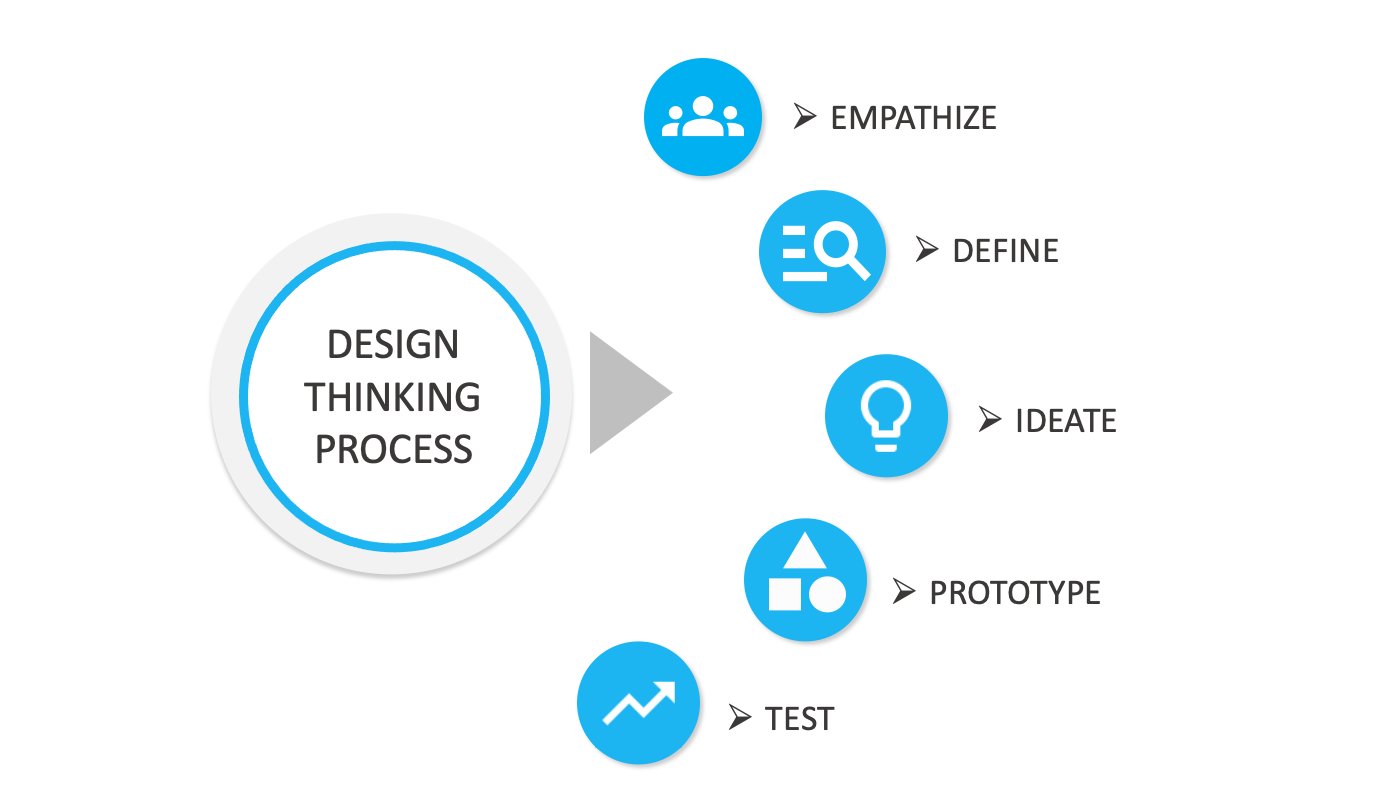 Contrary to its name and background, design thinking is not just for designers, and it can support your innovation efforts too. Design thinking is the human centered approach to innovation that wants to find solutions to complex problems by focusing on understanding the user.
Contrary to its name and background, design thinking is not just for designers, and it can support your innovation efforts too. Design thinking is the human centered approach to innovation that wants to find solutions to complex problems by focusing on understanding the user.
When we look at design thinking through the lenses of the scientific method, we can understand why design thinking is not just a buzz word, but an innovation method easily adaptable in different fields and areas. The scientific method emphasizes experimentation, discovery and inductive reasoning.
Design thinking was further developed and adapted for business needs. It includes observation and discovery of human behaviour and makes use of data to create solutions to complex business problems.
How it’s done: Design thinking can be applied by project managers, product managers, or innovators looking to create solutions based on educated hypotheses and testing.
- First, you empathize with the users and try to understand their behaviour through survey, questioning or interviews.
- Second, use the gathered data to understand and define the problem and the context around it.
- Next, build a first solution, the minimum viable product (MVP). Once this is done you can start testing and gather data that can confirm or dismiss your solution. It’s rarely the case that your first MVP is a final, refined solution. This is why the last step is very important: ideate & analyze.
- Lastly, once you have gathered enough feedback test it against your prototype and keep on improving on that.
Why choose this method:
Putting the customers at the heart of your innovation will help you develop creative solutions with value for the market.
- Provides a flexible framework that can easily be combined with other methods to complement your innovation activities
- Supports the pace of innovation as it can be implemented with agile, fast methods
- Cost effective: prototyping and testing products or services before going big will save money on the long term, as you don’t have to invest in something you are not sure if it will work
4. (Design) Sprint
What is about: Design sprints refer to a problem-solving, actionable framework derived from design thinking. Design sprints were first born at Google more than 10 years ago and to this day they are still used as a method to create and innovate.
Design Sprints and design thinking can often be confused. However, when we talk about design sprints, we know it refers strictly to a problem-solving method. Unlike design thinking, design sprints start with a well-defined challenge and focus solely on the solution. Also, unlike design thinking which can use many tools for each of the six stages, design sprints have very structured practices that can spread throughout five days.
How it’s done: going into the full details of a design sprint is beyond the scope of this article, but for a better understanding, we summarized the five common steps.
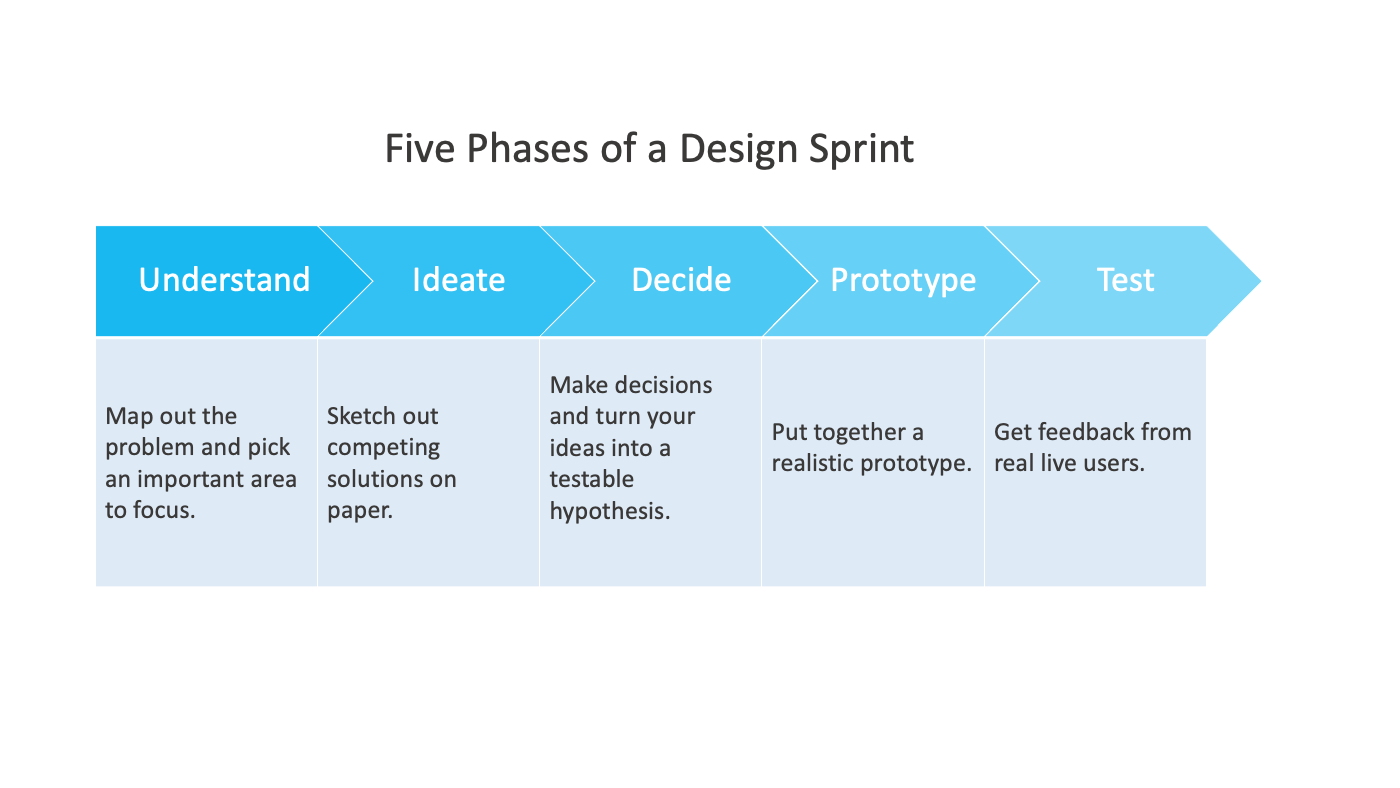
Why choose this method:
- Use short bursts of creativity to come up with new results
- Tackle small tasks fast, no time wasted with decision-making meetings
- Focus on prototyping and delivering a testable product
- Test assumptions early in the development process.
5. Agile (thinking)
What is about: Agile thinking is another method that nicely complements design thinking because both can be used by companies that want to become more innovative and customer centric.
Unlike design thinking, Agile is primarily focused on project management and increasing speed by managing flow-optimization of a development process. Initially created for software developers to increase efficiency and speed, Agile has now become a widespread project management method that supports innovation throughout organizations.
How it’s done: As many organizations nowadays operate in a highly dynamic environment, the Agile approach can fit a variety of industries pretty well. While still used primarily by software development teams, agile approaches also proved efficient for product development, marketing projects, strategic-planning activities, supply chain challenges or resource allocation decisions.
For example, Agile can be successfully applied in areas where complex problems can be broken into modules and tackled by creative multidisciplinary teams, like in strategic planning and marketing.
Agile can be successfully applied in areas where complex problems can be broken into modules and tackled by creative multidisciplinary teams, like in strategic planning and marketing.
While the theory might sound simple, an Agile approach requires training, behavioural change and sometimes new information technologies, so, decision makers have to assess if this is something they can commit to. To make an informed decision, it’s important to understand what agile is and isn’t, what are the guiding principles and requirements.
Even though Agile is more of a mindset, there are several methodologies that take it from concept to practice. So, to make it easier to understand we’ve briefly introduced below the three agile practices, scrum, Kanban and lean development.
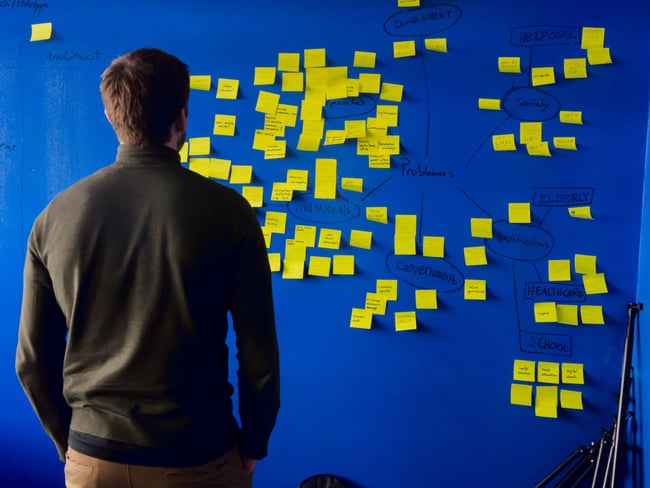
- Scrum is a framework for continuously improving and developing complex products and it’s emphasizing creativity and team-work.
- Kanban: highly visual workflow management method for defining, managing and improving services that deliver knowledge work. It’s focused on reducing lead times and the amount of work in process.
- Lean methodology: at its core, Lean is about optimizing people, resources, effort, and energy by focusing on the continual elimination of waste
Why chose this method:
- Practices like Scrum can facilitate radical breakthroughs
- It maximizes the contributions of team members and facilitates rapid response through flexible team structures and work cycles
- Minimizes the waste that comes with redundant meetings, repetitive planning, excessive documentation, quality defects, and low-value product features
- Improves customer engagement and satisfaction
- Brings the most valuable products and features to market faster and more predictably, and reduces risks
6. Blue Ocean Strategy
What is about: Blue Ocean Strategy is a theory developed by W. Chan Kim and Renée Mauborgne in their book with the same title. Their approach includes a set of tools and frameworks that enable companies to capture “blue oceans” which are the unexplored areas of the market.
It can be used to pursue differentiation, open up new market spaces and create new demand. The authors point out that fighting with competitors on a crowded market, the red oceans, is rarely a winning strategy, and by creating an uncontested market space for yourself, you are paving your way to success.
How it’s done: The Blue Ocean Strategy is about creating value for the customer while also keeping costs low. This goes against the more traditional approaches where you choose either low cost or high value.
There are five steps in shifting from the red oceans to the blue ones:
1. Choose where to start and build your team. Using the Pioneers-Migrators-Settlers Map, aim at having more migrators and pioneers than settlers.
2. Understand where you are by building a simple picture with the Strategy Canvas.
3. Uncover what limits the size of your industry and discover the blue oceans of new customers.
4. Find out how to get there by systematically reconstructing market boundaries and develop alternative blue ocean opportunities.
5. Choose how to advance, do rapid market test and launch.
Why chose this method:
- The Blue Ocean Strategy is focusing on moving away from traditional strategic models and towards value innovation as the backbone of growth potential.
- It enables a change in mindset that allows for horizons expansion towards new opportunities.
- Pursuing blue oceans means that your customers won’t have to choose between value or affordability because you will simultaneously pursue low cost and high value.
7. Jobs to be Done
What is about: Jobs To Be Done is a framework for identifying customer needs. It’s all about finding out what kind of jobs consumers hire their products to do.
Going deeper, to the root causes of customers choices, you open the door to real, value-adding innovation.
These are the needs customers often didn’t even know they had. In an HBR article, Clayton Christensen explains how this framework works and why companies win with innovation once they understand how and why customers make certain decisions.
How it’s done:
To win with JTBD you have to first define your market in a new way. Your competitors are not necessarily those that create similar products, but those that help consumers get similar jobs done. For example, Netflix is not competing just with Amazon or other streaming services. They are competing with anything that help people relax, be it a bottle of wine, board games or video games.
Next, identify the customers that would benefit from getting the job done and find the unmet needs. Once you know who your customers could be, analyze the competition and how they perform at satisfying customer needs. Once you have all the information get on generating new ideas that can solve the unmet needs and prioritize based on what ideas can get the job done faster and more accurately.
Why chose this method:
It’s important to look at products through the lens of jobs to be done because you’ll be able to broaden your business horizons and identify new opportunities that others haven’t already tackled.
- Understanding the jobs your products or services do for the customers will help employees align around a common purpose which can become the North Star.
- If you focus on defining these jobs you can benefit from distributed decision making, which means that employees are empowered to make good decisions, be autonomous and innovative.
- Help you optimize resources as focusing on specific jobs will emphasize what matters most and where you should actually invest your resources and energy.
- Jobs to be done serves as a guide for innovation because it enables a comprehensive insight into what is needed to create the right solutions
How to choose an innovation method
When choosing your innovation methods, there are various factors that influence your decision. From the stage in the innovation process to the types of innovation you pursue or the industry you activate in, all these are important things to consider.
When choosing your innovation methods there are various factors that influence your decision. From the stage of the innovation process to the types of innovation you pursue or the industry you activate in, all these are important things to consider.
However, because there is no one size fits all, it’s best to choose a method according to your specific case. Generally speaking, there are several steps that lead to finding an innovative solution. Different methods can be applied to different stages of an innovation process.
We outlined below five general steps that take you through the innovation process, but these can be customized according to your needs and specifics. Some innovators might have three stages, others might go with eight. It’s up to you to explore and navigate the best innovation process for you, from idea to implementation.
Now let’s have a look at the standard steps of an innovation process and the possible application of the above-mentioned methods.
1. Idea generation and mobilization
Generating ideas is the starting point for any innovation, but before even getting there we need some generic information on the environment and ecosystem in which those ideas will flourish. This is why a method like innovation mapping can come in handy to understand your specific environment. Once you have that in place you can decide how you want to generate ideas. You can choose a tool like Viima for the ideation process or choose to organize a hackathon.
Next, is the mobilization phase. Mobilizing ideas can mean to move them to a different physical or logical location and whether that means a different department or team or developing them into a less abstract concept, it is crucial not to skip this step.
2. Advocacy and screening
This stage is about weighing the pros and the cons and deciding which ideas can be picked up for further development. Having a standardized, transparent process to do this also diminishes the risk of people rejecting the new ideas because of their own biases. While a method like jobs to be done is not specifically used to evaluate ideas, it is a method that helps with decision-making.
Even though Idea evaluation plays an important role, we won’t go too deep into details here as we already wrote extensively about it in a pervious article. However, it’s important to keep in mind that idea screening and evaluation can and should be based on rational metrics that a well-run business already has in place.
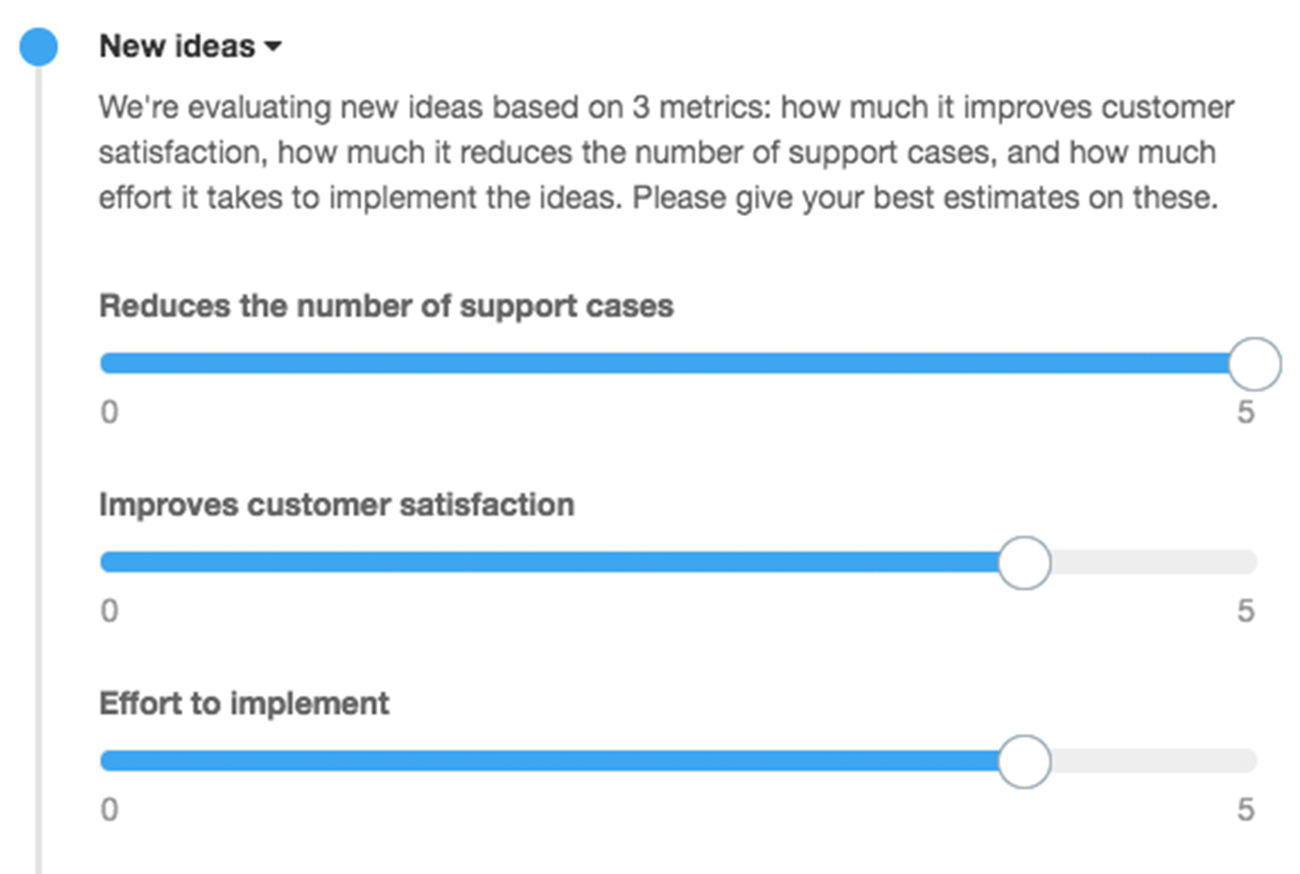
While evaluating ideas can become complex, it’s good to consider both qualitative and quantitative metrics and clearly and transparently communicate them to everyone. This will encourage people to contribute as they will understand why their ideas have been chosen for further development or not.
3. Experimentation
In this stage ideas are tested in a particular environment and for a specific audience. Because at this moment you want to understand very well who your customer will be, methods like design thinking and design sprints will come in handy.
During this phase organization can create prototypes and get user feedback without making huge investments. In a short period of time, you’ll have something for your audience to test and based on those first results, you can further develop your product or service.
4. Commercialization
During this stage innovations move from development to persuasion. The commercialization step is focusing on creating market value for an idea by focusing on the potential impact. Can it bring value to customers, is it appealing, to they understand when and how to use it?
Rapid experimentation and using data as market evidence contributes to successful commercialization. Agile methods like Lean methodology can be deployed to the commercialization stage to identify areas of uncertainty like market segments, marketing channels, messaging, pricing, sales model and so on.
Using the lean principles of the agile method, empathy, experimentation and evidence can help decide on an action plan for execution and scaling. In his phase there is a tendency to fall back in the old ways of doing things, but for greater outcomes, it’s important for organizations to adopt new ways of thinking.
5. Diffusion and Implementation
In the last stage of the innovation process, you are looking for the companywide acceptance of the idea you’ve been working on, which we call the diffusion. This can be done through different internal communication channels and methods that can vary depending on internal practices and the company’s culture.
Next on the list is a proper implementation plan that includes resource allocation, a marketing plan as well as feedback collection which will help identify opportunities for the next innovative ideas.
It’s important to set metrics that indicate the success of your innovation, and it’s just as important to leave room for further steps of improvement. After all, innovation is a continuous, long-term process that never ends. After one innovation, you should already look into ways to start all over again.
How to get started
Having so many options can become overwhelming, but this shouldn’t discourage you. Start by asking the right questions. What is the purpose of your innovation and is it answering a real business need?
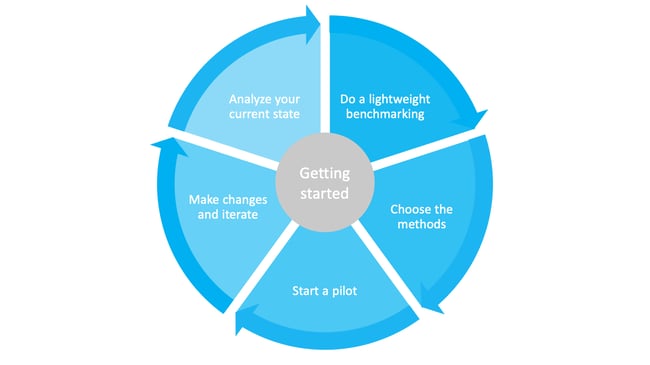
These are the first questions to ask yourself, then you can proceed with the next steps that will help you choose the right innovation methods. Any company doing innovation has some sort of methods in place, even though they might not always be clearly defined. So you rarely start from scratch.
- Analyze the current state and map out what is currently being used. What are the challenges with the way you do things now? Are there certain stages for which you don’t have a systematic method in place?
- To determine the performance of your initiatives and decide what to improve, it’s good to have a frame of reference. For a holistic view of your organization’s innovation do a lightweight benchmarking. The purpose is not to copy others’ methods, but to understand how they are being used in different contexts.
- Put things together with a canvas like the one we created for you and fill out the blanks with the possible methods you think are worth piloting. Try to find a good balance, don’t go overboard by trying to test them all and don’t get stuck on a single method.
- Start a pilot with the methods you chose and see how they play out.
- Adapt and iterate based on what you’ve learned
Conclusion
When it comes to innovation, a good approach is to start backwards. Working backwards, like Mark Johnson suggested in the first episode of our Innovation Room Podcast, is about thinking what could have a real impact in 5, 10 or more years from now. What can you do today to shape the future? Anticipate, rather than react and take a step back to analyze your current position, as well as your short and long-term goals.
It’s important to remember that there is no single method that will bring the best results, but rather a combination you need to discover on your own. How you combine and adapt them depends on your innovation stage, type of innovation, industry and much more.
To help you in the process of choosing the right innovation methods, we put together a canvas which you can download here.
Interested in Innovation and Leadership?
Subscribe to our blog to get the latest stories on innovation, leadership and culture straight to your inbox.




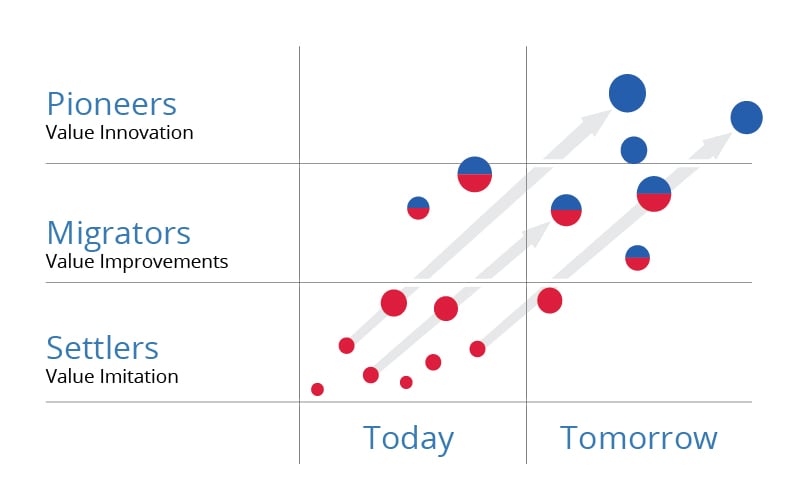
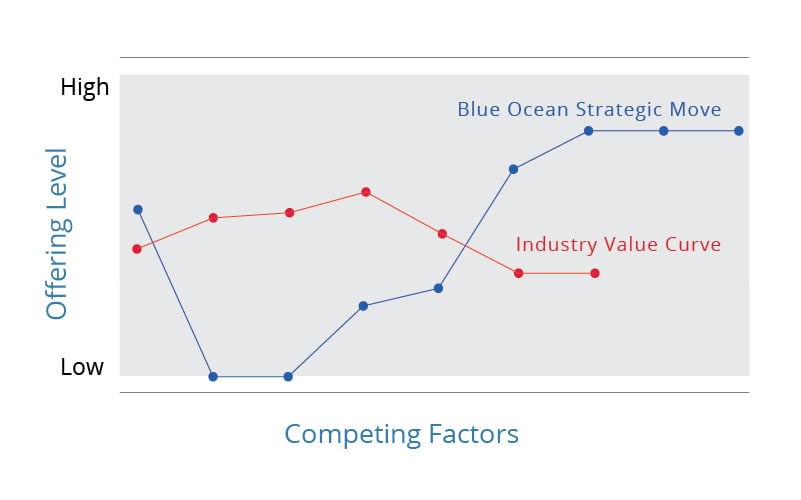
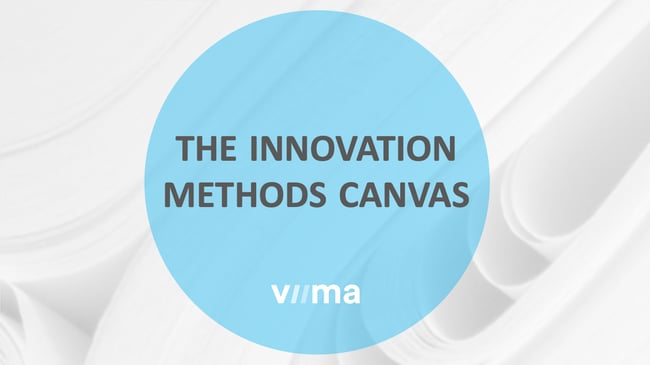



.jpg)
